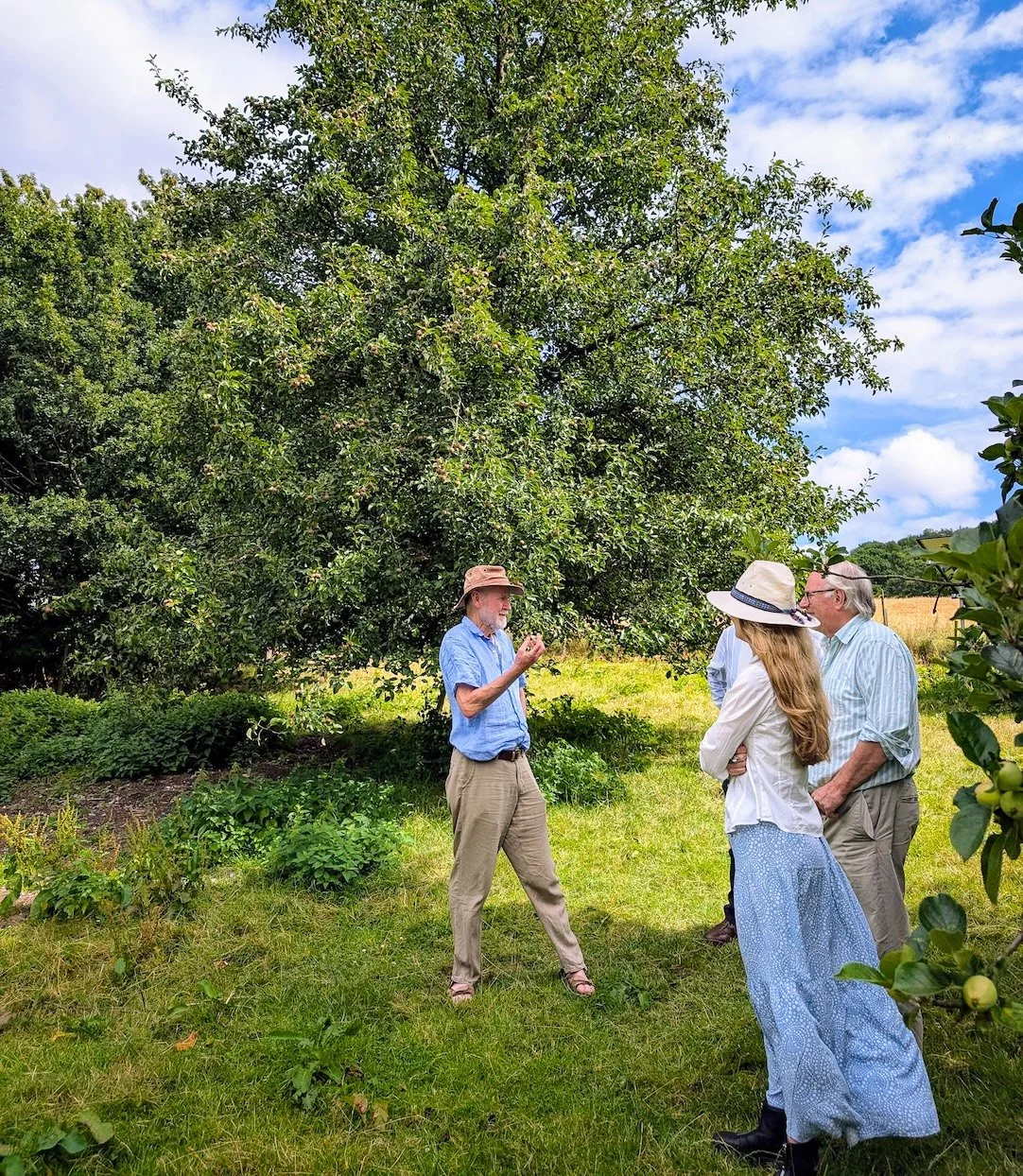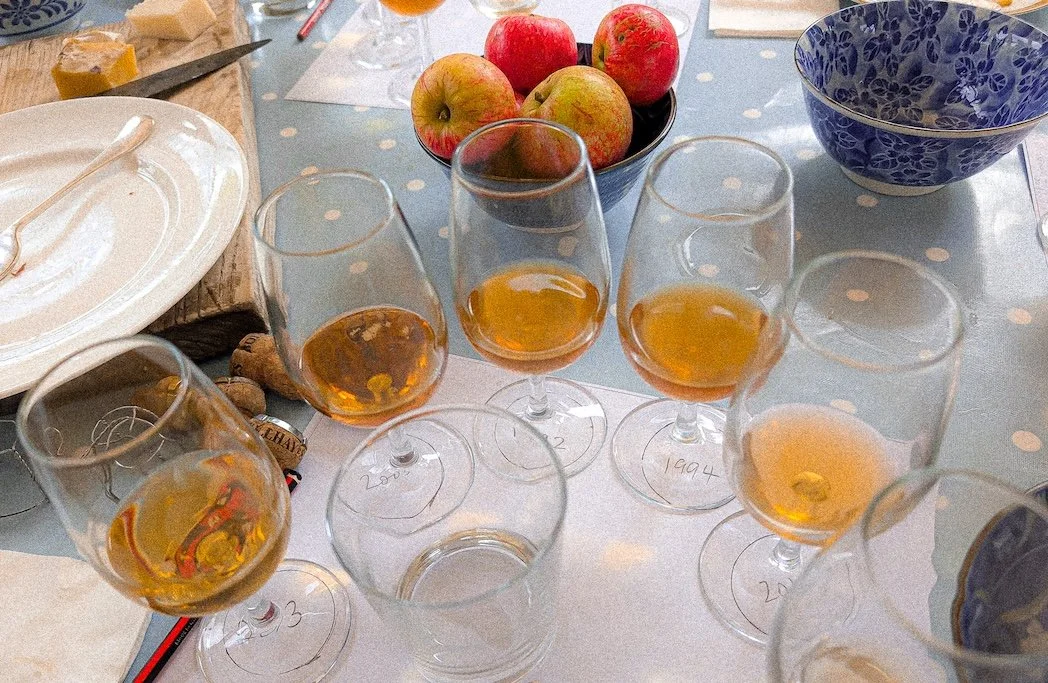AI vs Authenticity: Tasting Vintage Cider with the West Country’s Leading Experts
AI, Processed Information, and the Value of First-Hand Experience
This week Google announced a new way of browsing for information online - a system that relies on artificial intelligence to find out, describe or explain whatever it is you wish to learn. Which will no doubt be very useful. But, as an expert told the BBC Today programme, it’s the information equivalent of highly-processed food - and I know what most readers of this newspaper will think of that.
The Hesp Out West pages which appear every weekend in the Western Morning News and Western Daily Press were designed to be the antidote to anything that AI can offer. In other words, these articles are all about experiencing something first-hand, whether it’s a enjoying walk across a Westcountry hilltop, learning how to fillet a fish, or luxuriating on a Mediterranean cruise.
cider tasting notes - photo C Crowden
The point being, that no robot is able to deliver a genuine account, because no robot will ever be sent out to experience such a thing. Not for a long time yet, anyway. All AI can do is borrow or steal from some real-life human experience that’s already been written about, and come up with some bland account of its own.
I believe there will be an increasing need for the delivery of “authentic real-life experience” as time goes by, whether it’s by the written word, on radio or podcast, or via TV or Youtube. Humans want genuine input from other people, not ultra-processed or regurgitated information handed out by an AI powered conveyor-belt.
A West Country Cider Experience No AI Could Replicate
So when my friend James Crowden invited me to a special Westcountry lunch where rare vintage ciders and perrys were going to be tasted, I couldn’t possibly say no. No robot would ever be invited to such an event - certainly not until they invent one with the ability to taste and sniff. As its is, AI can only borrow what other people have said about a certain product and then make vague assumptions.
Cider writer James Crowden
I’ve just asked Google Gemini: “Describe the taste and complexities of a bottle of 2003 Bollhayes Cider…”
It replies with a pretty reasonable: “It would likely have a full-bodied, rich, and dry flavour profile with notes of classic spicy and citrusy characteristics.”
Note the “would likely”. It has searched online descriptions made at multiple vintage cider tastings - originally written by living, breathing, sipping, slurping, humans - and rounded them up to create a bland cover-all.
Hesp and Crowden - photo Carla Crowden
Real Tasting Notes from Real People
James jotted down a more specific observation of the 2003 cider we sampled last week: “Hefty tannins, now smoothed out after 20 years-plus. Almost smoky - a burnished bronze. Complex deep notes, with a strong hint of phenolics. Very dry. Just the right sort of medicine for a long slow lunch.”
And a long slow lunch is exactly what we were enjoying at the Devon home of Alex Hill - for many years owner of the aforementioned Bollhayes Cider and also a legend in both craft cider, beer and even wine circles. And I mean legend, although Alex - a quietly spoken and charming man - would, in his modest way, detest such a description. The fact is that over 40 years ago he founded Vigo, a Devon-based company now widely regarded as the leading UK supplier of commercial cider making equipment. Vigo sells an extensive range of beer brewing and wine-making equipment.
Alex Hill shows cider samplers around his orchard
The learned Mr Hill is nowadays enjoying an active retirement, having sold the Bollhayes brand to a Devon family, which continues to make very good sparkling cider indeed. Vigo Ltd still based at Dunkeswell not far from Alex’s home, is now part of the Rawlings Group which supplies “carefully chosen equipment and consumables to drink producers”. Next door is Vigo Presses run by Paul Courteney which caters for small scale artisan cider makers.
A Gathering of the UK’s Cider Greats
Relevant to our special cider-tasting lunch last week was the fact that, having made the stuff for many years, Alex still has a few vintage bottles of Bollhayes - and it was most generous of him to open some of these at our tasting attended by a select handful of the nation’s top cider experts. Notably, Dr Andrew Lea, a leading tannin expert and chemist and a cider-maker from Oxfordshire. Andrew won his spurs while working at the now sadly defunct Long Ashton Cider research centre, a famous institution based just outside Bristol. He is author of the seminal tome, Craft Cider Making.
Dr Andrew Lea
We were also joined by Adam Wells, a dynamic young author who runs the much-acclaimed Insights on World Cider and Perry blog. Adam travels around the world sampling, writing about, and judging fermented drinks made from the fruit of orchards, so we were honoured to have him among our number.
Cider writer Adam Wells
The same applies to Nick Pring, a well-known figure on the West Country cider-making scene - he used to run the Devon-based giant and now sadly-missed Whiteways Cider and also, later in his career, Green Valley Cider.
Man behind 2 million pints, Nick Pring
James Crowden, arguably the most famous cider writer of them all (author of best-selling Cider Country and Ciderland, among other titles) helped organise the get-together, ably aided and abetted by his wife Carla (who turned out to have the most finely tuned nose and palette of us all).
Carla Crowden
Rare Bottles and Their Complex Profiles
Why an old reprobate like me was invited to join such learned luminaries, I have no idea, but at least my journalistic abilities allowed me to observe and prepare this article. The rare liquids we tasted were Bollhayes sparkling cider made in 1992, 1994, 2003, 2013 and 2020, as well as a 23 year-old Gloucestershire perry and one or two ciders and perries from Ukraine bottled before the present conflict.
And when I say rare, the 1992 was the last bottle of its kind in the world.
I’ll let James describe it… “Surprisingly lively and sparkling, even mantling in the glass, with good head and fruity nose after 33 years. Fresh as a daisy, brilliant. slight apricot. The last bottle now, alas, has gone.”
As for the 1994… “Lost its fizz, but deep dark and complex, more like Madeira or an aged sherry. To be sipped gently by the fireside.” The Crowden take on the 2013… “A mere youngster compared to the others but still lively and very dry. Drink now!”
James became even more effusive when it came to the 2001 sparkling perry Last Hurrah from Kevin Minchew in Gloucestershire and Tom Oliver in Herefordshire. “Moorcroft perry pears - aka Stinking Bishop, hand-picked from Gorse Hill. A rich smooth elegant drink fermented in whisky barrels then bottled a year later at Three Choirs Vineyard. Definitely a one off. Only 1,000 bottles made, now alas all gone. A hark back to the past when Herefordshire makers pioneered the aforesaid process now known as methode champenoise.”
The Importance of Tannins in Traditional Cider
Much of the talk touched upon the all-important tannins which are to be found in the kind of “grown up” drinks we were sampling. Why are they so important, I asked Andrew?
“Because they provide a balance, a bitterness, or an astringency. They provide body,” he replied. “You find them in most liquid type foods, but they’re mostly associated with beverages. Certainly, Alex’s wonderful ciders have them and they are what makes these vintage drinks so special.”
Andrew recalled the time when he was looking at tannins for a project designed to help improve commercial cider. “Unfortunately, the cider marketing people decided an easier route was to just tell the customers they didn’t like tannins and couldn’t have them. They did that because the lager boom was overtaking the UK at time and there are no tannins in lager. Or, at least, less than any other beer. So people were being weaned off tannins.”
He added: “Today, the most interesting thing from the commercial point of view is how far can they develop the quality cider market? If at all? Because, I have to say, in my 50 years in the business there have been many false starts.”
Can High-Quality Cider Survive in the UK Market?
Which brings us to the most important question of all. Is there a future for such high quality traditionally-made local drinks in this country?
I asked Nick Pring who was once described as “The Man Behind 200 Million Pints” when he was managing the Wimple team at Whiteways… “There is a bit of a renaissance happening in the commercial market,” he commented. “I’m not saying they’re all good - don’t just look at the labels in the supermarkets - it depends on who’s actually made the cider.
“It is quite hard to break into the commercial market. It is much easier to make a good product than it is to sell a good product. Let’s hope that might change as young people get a taste of the finer ciders being made across this region nowadays.”
I asked Adam Wells for his view on the cider renaissance. “You have to remember there’s barely even a handful of corporations dominating the cider market and, unfortunately in the UK, it can legally be made with just 35 percent juice, which can all be from concentrate.
“That is an entirely different drink to the sort of thing we’ve been trying here. But there is a rise in what I’ve come to call ‘aspirational cider’, other people call it ‘fine cider’. There are more producers who want, not only make a full juice product, but one that showcases our incredible variety of apples.
“But there has to be what you might call high-value consumer perception,” he added. “So you stick it on a dinner table and your guest says… ‘Yeah, that looks like it’s something special!’. Fundamentally, cider is a fermented drink made from a particular fruit, just like wine. And, as wine and whisky shows, there is a market for the very best - people will pay for something very special - and if you are making one of the best ciders in the entire world why shouldn’t you ask a decent amount?
“The only question is whether that can sustain orchard growers and also whether it gives the producer enough money. There’s enormous amount to be said for people pricing a drink relative to the effort they put in and to what they need to survive as a small business.
“Most quality ciders you see in 750 ml bottles in this country will start at around £8 or £10 and about £15. In some cases, they might go a little bit higher, but we’re really talking a very narrow range compared to wine - and I think, when you consider it’s a vintage product which can only be made once a year, then those are reasonable prices. All that’s needed it for people like you and me to convince consumers they’re worth it.”
Well, I’m giving that ago here in these pages - you can also read Adam’s blog at https://cider-review.com - or even, if push comes to shove, get the AI robots to help you find the best of British ciders.
Bollhayes Park




















